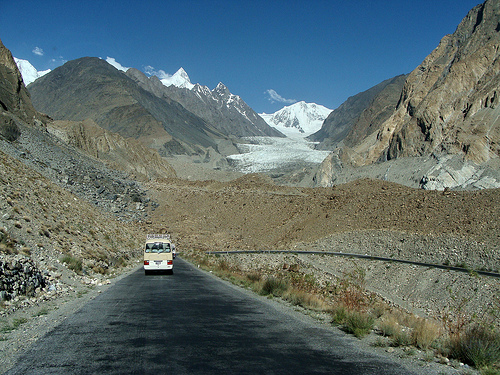
The Karakoram Corridor: China’s Transportation Network in Pakistan
Publication: China Brief Volume: 10 Issue: 20
By:

In China’s quest to secure raw materials, resources and markets, Beijing has laid out a sophisticated blueprint to develop a region-wide transit corridor throughout the subcontinent. In the Himalayas, it has built rail, road and air networks that can support the Chinese military’s logistic supply chains and showcase its capability to overcome the tyranny of geography. The transportation network through the Karakoram mountain range is particularly noteworthy. Notably, the corridor provides Chinese access to Pakistan that can be extended in the future to provide connectivity to the Indian Ocean and to the energy rich Persian Gulf, particularly Iran. Furthermore, the modernization of the regional transit infrastructure will be conducive to stronger connectivity between South Asia and the Central Asian Republics, yet at the same time it will expose China’s borders to the region’s growing security challenges.
Background
Islamabad has wholeheartedly supported China’s infrastructure development projects. In 1963, Pakistan ceded more than five thousand square kilometers of territory in Pakistan Occupied Kashmir (POK), which is claimed by India [1]. This culminated in the construction of the Karakoram Highway that links China with Pakistan.
During his most recent visit to China in July 2010, Pakistan’s president Asif Ali Zardari sought Chinese assistance to augment infrastructure and improve connectivity between landlocked Xinjiang and Pakistan (Indian Express, July 7). The proposals reportedly included upgrading the existing Karakoram Highway and building a rail link along the route connecting Pakistan with Xinjiang via Gilgit-Baltistan. Pakistan also urged China to capitalize on the potential of Gwadar port as a transit point for trade between Xinjiang and the Arabian Sea (Srilankaguardian.org, July 10). In essence, the above transportation infrastructure projects would result in greater connectivity from which both countries would accrue the benefits.
Karakoram Highway
The 1,300 kilometer-Karakoram Highway (National Highway 35 or N35), also dubbed "Friendship Highway," links Islamabad with Kashgar in Xinjiang. It is the highest metal road in the world and it took nearly two decades to build, during which there were several casualties including 810 Pakistani and 82 Chinese deaths due to adverse weather conditions, landslides and accidents (Pakistanpaedia.com, January 20, 2009). In 2006, Pakistan Highway Administration and China’s State-owned Assets Supervision and Administration Commission (SASAC) agreed to widen the highway from 10 to 30 meters and upgrade it to make it accessible by motor vehicles during extreme weather conditions (News3.xinhuanet.com, July 8, 2006). China completed the widening of the highway on its side but Pakistan could not raise the funds, which delayed the project. As a result, China agreed to give Pakistan a soft loan for the project (Southasiaanalysis.org, September 5).
In January 2010, the Karakoram Highway was submerged due to a severe land slide in the Hunza valley in the Northern Areas of Gilgit-Baltistan. This resulted in the formation of a 20 kilometer-long artificial lake over the highway that contained over 132 million cubic meters of water, causing a major disruption of traffic between China and Pakistan (Desicritics.org, March 13). By June, the lake had overflowed and according to the Indian Army, "it could take one-and-a-half years for normalcy to be restored to the functioning of the highway" (Deccan Chronicle [India], July 18). Pakistan’s National Centre of Excellence in Geology at the University of Peshawar has assessed that there are several uncertainties about the Karakoram region due to landslides and the formation of artificial lakes, which could result in floods (Thenews.com.pk, May 22).
In late July 2010, northern areas in Pakistan witnessed heavy rains, causing major flooding in Gilgit-Baltistan region. China dispatched rescue and medical teams to the region and deployed helicopters that ferried medicines and relief materials (Rediff.com, September 26). The Chinese engineering teams, which included military personnel, carried out repairs to the Karakoram Highway and restored the movement of vehicles. By September 1, over one hundred Chinese trucks carrying food materials from Xinjiang reached Sust Dry Port in Pakistan via the Khunjerab Pass. Notwithstanding the vulnerability of the region due to natural causes, the melting of glaciers and adversarial impacts of climate change resulting in floods, China has exhibited its capacity to maintain connectivity to the region.
The Karakoram Rail Corridor
The joint China-Pakistan project to link Kashgar in Xinjiang to Havelian near Rawalpindi in Pakistan through the Khunjerab Pass in the Karakoram Range through a rail corridor is indeed ambitious (Rupeenews.com, July 7). It has been noted that the rail track running nearly 700 kilometers "will transform the geopolitics of western China and the subcontinent" and "while the technical aspects of the trans-Karakoram rail link are daunting, there is no denying the Chinese audacity in embracing projects that are grand in conception, challenging in their execution, and consequential in their impact" (Gilgit Baltistan Tribune, July 10). The rail project is likely to be undertaken by a joint consortium of Pakistan and China Railways. The details of financing, routing and construction of the railway line are yet to be finalized.
Connecting Gwadar and Xinjiang
At the southern end of the Karakoram corridor is the Gwadar port overlooking the Arabian Sea. The port offers several strategic advantages to China. In economic terms, it can potentially link Xinjiang to the global trading system through the Karakoram Highway. Pakistan has urged China to use and "take maximum benefits from the Gwadar port" (C3sindia.org, September 20). The Gwadar port was built with Chinese financial assistance (80 percent of its initial $248 million development costs) and was offered to the Port of Singapore Authority (PSA) to conduct shipping operations in February 2007 for 40 years. The port performance has been unsatisfactory; only 72 ships have brought government cargo to Gwadar Port and PSA was reluctant to make a further investment of $525 million in next five years (Daily Time [Islamabad], January 3)
Pakistan is keen that China constructs oil/gas pipelines from Gwadar to Xinjiang ostensibly to transport Iranian gas that was earlier part of the Iran-Pakistan-India pipeline project, which was shelved by India. Earlier, in 2008, Yang Jiechi, the Chinese foreign minister, had stated that China was "seriously studying Pakistan’s proposal to participate in the IPI gas pipeline project" (Asia Times, May 9).
Besides economic opportunities, there are several strategic gains that China can accrue to protect its interests in the Indian Ocean. Gwadar has received international attention and is characterized as an important node in the Chinese "string of pearls" strategy. Gwadar offers China a "forward facility" for staging the PLA Navy in the future to protect Chinese flagged shipping transiting through the Straits of Hormuz, a critical choke point in its energy supply chain strategy.
Security Threats and Proliferation Risks
China is concerned about the possibility of these transport networks in the POK serving as a conduit for the movement of Islamist/terrorist elements that could establish links with separatist movements in the Xinjiang (Ict.org.il, January 21). China has urged Pakistan to crack down on anti-Chinese extremist groups operating from Pakistani territory. During President Asif Ali Zardari’s visit to Beijing in July 2010, President Hu Jintao noted that "To strengthen Sino-Pakistani anti-terrorism cooperation and strike at terrorism, separatism and religious extremism is in the fundamental interests of the peoples of both nations" (AFP, July 7). Further, Wu Bangguo, chairman of the Standing Committee of the National People’s Congress, has noted that "We should work together to deepen bilateral cooperation in defense security and other sectors" (The Times of India, June 17).
China is also concerned about the insurgency in the restive Baluchistan province. Chinese engineers working on infrastructure projects have been kidnapped in the past. In a recent attack in July 2010, unidentified assailants fired rockets at a five -star hotel where Chinese engineers working on an oil refinery were staying (Daily Times, July 8). Significantly, the rockets were fired "from the sea" and Baloch Liberation Front (BLF), an insurgent group, claimed responsibility for the attack and warned foreign investors not to invest in Balochistan. The BLF also threatened to attack the Pakistan navy and coast guard ships (Balochwarna.com, July 7). Currently, there are about 10,000 Chinese in Pakistan working for 120 companies engaged in different sectors like mining, energy exploration and infrastructure building (Daily Times, July 20) and China has expressed concern for their safety.
These transit corridors could pose potential proliferation risks, as well. Already, the Karakoram has been identified as an artery for transferring illicit materials. For instance, in 2003, American satellites detected the movement of 12 consignments of Chinese missiles to Pakistan via Karakoram Highway (India News Online, September 1, 2003). The Chinese silkworm missiles to Pakistan followed the Karakoram route. Also, North Korea reportedly received Uranium enrichment equipment from the A Q Khan network through this route [2].
Challenges Ahead
The Chinese leadership has visibly transformed its frontier regions and extended its economic influence across borders. By converting strategic assets into economic opportunities, China’s trans-border infrastructure build-up is not just for military leverage but and also an instrument for the expansion of Chinese economic influence into the Subcontinent (Indian Express, July 6).
The above developments have caused anxiety in India and there is a firm belief among Indians that whatever China does in Pakistan is quintessentially targeted against India. Although both sides have attempted to keep their political and economic transactions buoyant through regular high level political exchanges and enhanced bilateral trade, which is expected to reach $60 billion by the end of 2010 (Chinadaily.com, August 19), there are open wounds in their relationship, particularly in the security domain.
The Indian military has noted that the aforementioned transport networks serve as a conduit for supply of Chinese military hardware to Pakistan (Deccan Chronicle, June 13) and China could deploy troops during periods of tension that could act as a pressure point on India [3]. Reacting to reports on the building of highways in the disputed Gilgit-Baltistan region in POK, the Indian minister of state for defense, M M Pallam Raju, has stated, "we are taking our counter measures and we are doing our own preparation" (News.rediff.com, July 9).
China has identified several pressure points against India; Arunachal Pradesh in the east, which has witnessed regular intrusion by the PLA and augmentation of military infrastructure along the Himalayas; Pakistan in the west, which enjoys "all weather friendship" with China and receives generous assistance of nuclear technology and supply of military hardware; Nepal in the north with suspected support of the Maoists who are seeking political control of the state; and POK can be added to this list.
Yet, there are several challenges for Beijing in its drive to build infrastructure in POK. While China may be able to overcome the tyranny of geography and absorb the financial cost of infrastructure projects, Islamabad’s apparent inability to control Islamic groups, and above all the unpredictability of the security situation, as well as the impact of climate change in the Himalayas, will be daunting—even for the Chinese.
1. Kashmir: The True Story, External Publicity Division, Ministry of External Affairs, New Delhi: 2.
2. Richard Bond, The Proliferation Security Initiatives: Targeting Iran and North Korea, Occasional Paper on International Security Policy, Number 53, January 2003, British American Security Council.
3. Author’s discussions with retired Indian Army officers.
[The views expressed in the above article are the author’s own and do not reflect the policy or position of the Indian Council of World Affairs.]





